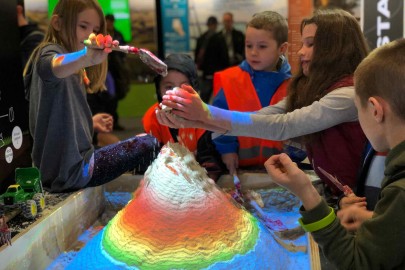Augmented reality sandpit
In this section
-
Visiting Te Rauhītanga – The Gathering Place
- Kōwhaiwhai
- A story of Haumia Tiketike – He kōrero mō Haumia Tiketike
- A story of Rongo – He korero mō Rongo
- A story of Tāne – He kōrero mō Tāne
- Carvings – Whakairo
- The names of our buildings
- The names of our meeting rooms
- Virtual reality: Karanga a Tāne Mahuta
- Rene Orchiston Flax Collection – He Kohinga harakeke nā Rene Orchiston
- Banks and Solander prints
- Invertebrate illustrations
- Biodiversity display
- Weed and predator control display
- Land video wall
- Historic soil maps
- Soil classification illustrations
- Augmented reality sandpit
- Beech tree cores

The augmented reality sandpit on display at Fieldays.
Our augmented reality sandpit now resides in Main Street at our Lincoln site after being on tour, visiting two Fieldays events. The sandpit explores the idea of creating a resilient landscape and challenges users to balance their land use decisions to benefit the environment whilst retaining economic value..
Visitors can build landscapes, change contours and finally, make land use decisions. They will be able to add or remove tiles representing any of the following land uses:
- dairy farm
- sheep & beef farm
- cereal crops
- plantation pine forest
- native forest
- conservation land
They will then see the impact these choices have on greenhouse gases, economic output, biodiversity and water quality through a screen on the back wall that is updated in real time.
How does it work?
The sandpit uses a computer projector and a Kinect 3D camera mounted above a box of sand. The visitor interacts with the exhibit by shaping special “kinetic” sand in a basin. The Kinect camera detects the distance to the sand below, while a visualisation and elevation model with contour lines and a colour map assigned by elevation is cast from an overhead projector onto the surface of the sand.
As visitors move the sand, the Kinect camera perceives changes in the distance to the sand surface, and the projected colours and contour lines change accordingly. When an object (for example, a hand) is sensed at a particular height (~2 ft. / 60cm.) above the surface of the sand, virtual rain appears as a blue, shimmering visualisation on the surface below. The water appears to flow down the slopes to lower surfaces.
Who created it?
This technology was created by a team at UC Davis based in California, USA, who designed and programmed the AR Sandbox software. This is available to download from their website for free. We have further enhanced the sandpit experience by adding land-use buttons for visitors to create a landscape that optimises both environmental and economic outputs.